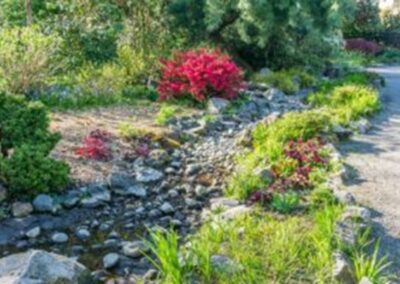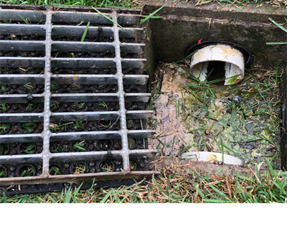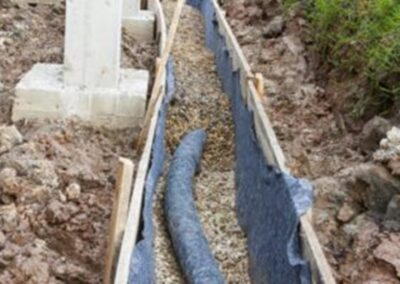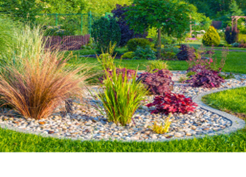
Landscape Drainage
Water drainage problems in the yard decrease property value and can lead to costly water damage to the house and other structures and plant and turf damage. Heading off such damage by remedying draining issues is usually less costly than repairing the water damage itself.
Our experts understand that proper drainage is essential in protecting your landscaping investment by helping divert surface water away from valuable trees and other plants and preventing standing water on lawns and landscapes.
Frontier Landscaping provides the following landscape drainage solutions.
- Rain garden
- Soil augmentation
- Dry well
- Channel drain
- French drain
- Catch basin
- Lawn drain
- Dry creek beds
- Planting
- Boulders
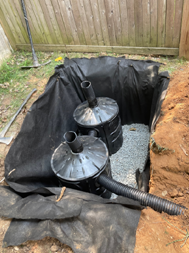
Dry Creek Bed
We can install a dry creek bed to provide attractive and functional relief, especially if your landscape has standing water. Dry creek beds are an excellent choice for addressing places in the landscape that are hard-hit by heavy rains. This drainage solution can be a nice addition to the look of your landscape by using different-sized rocks, boulders, and plantings.
French Drains
French drains are the most commonly used means of collecting, conducting and discharging water. This is a trench filled with gravel, sand, or rock (depending on application) and containing a perforated pipe that redirects surface water and groundwater away from an area. The perforated (“weeping”) pipe also allows small amounts to seep into the ground along the way.
Dry Well
A dry well is a hole that is lined with landscaping fabric and filled with gravel, creating an area where water will collect and percolate down into the soil. Dry wells are often placed in conjunction with several French drains; one may collect water, while another provides backup drainage. This creates a system that can handle larger volumes of water than a single French drain.
Soil Amendments and Boulders
Sometimes the best solution for a drainage problem is to amend the soil to take on characteristics of the native soil. By incorporating gravel, sand, or compost into the clay soil, you can create layers allowing the surface water to drain and seep into the soil. Boulders can help to stabilize soils and act as energy dissipater.
Channel Drains
Channel drains remove surface water from a designated area, helping to prevent flooding and overflows. These drains are also used to regulate water flow in an area, thereby reducing the strain on the system.
Lawn Drains and Catch Basins
Lawn drains and catch basins are small underground structures, typically covered by a metal or plastic grate, which catch runoff water. One or more branch drain pipes then carry this collected water from the basin to a termination point, usually near a street or into a municipal storm drain.
Rain Garden
Rain gardens are the perfect solution for curbing erosion and improving water quality. They collect rainwater and water that runs from your gutters and downspouts, creating runoff and filtering it away from your house. They are often created in shallow, landscaped depressions, which helps to naturally absorb rainwater in the ground. Planting helps stabilize the soil to prevent erosion and landscape drainage issues.
Frontier Landscaping has years of experience designing and implementing features that effectively carry water away from problem areas. Our expert installation team will determine the best place to collect excess water, the best method and route to conduct it, and an appropriate discharge point. We do the clean-up, too! Give us a call today!


